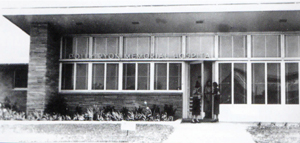A LITTLE PIECE OF HISTORY | By Joan Frances Photos from Fort Bend County Texas: A Pictorial History –

Fort Bend Hospital was the first public hospital constructed in Fort Bend County.
Over a century ago, health care was virtually non-existent. Assistance came from farmers or merchants who performed necessary duties, such as removing bullets, resetting broken bones or prescribing medications. The most common diseases settlers died from were cholera, malaria and yellow fever. Illnesses also came from poor sanitation, drainage problems and mosquitoes.
Natural disasters, such as flooding and hurricanes, also caused injury and death. Certified doctors were almost impossible to find until 1863, when a law was passed by the Texas Legislature requiring physicians to acquire a certificate to practice medicine. W.B. Cochran, MD, was the first recorded certified doctor in Fort Bend County.
When a member of the family was ill, a messenger, telegraph or loud bell summoned a doctor to their door. Day or night, the doctor would come to the home, carrying his Gladstone bag filled with a miracle cure for any aliment. Doctors faithfully made house calls for years before opening private offices. One of the most beneficial reasons was to gain a perspective on the family’s living situation. The patient was comfortable and less stressed in his own environment, but mainly, house calls allowed the doctor to get to know the family.
Personal relationships made a profound impact on the patient-doctor connection. Back then, it was not uncommon for a doctor to deliver babies, medicate them when ill, watch them grow into adulthood and later on, deliver their children. The doctor was considered part of the family and knew each member’s history. When someone was sick, frequent home visits by the doctor were anticipated. In most cases, the patient was seen every day for at least several days, even if it was a short visit and the talk was about the weather. Families trusted their physicians and believed in the care they provided.

Polly Ryan Memorial Hospital was completed with 51 beds and stood to serve anyone who came for care. In 1957, as the county grew, the facilities were expanded to care for the increasing number of patients.
In May 1919, four ambitious doctors in Richmond bought a two-story building and opened the first hospital in Fort Bend County. When a fire destroyed the building, J.S. Yates, MD, and J.W. Weeks, MD, leased the Will Baker home on 4th Street in Rosenberg to continue the medical practice. Two years later, they purchased the Kinch-Hillyer residence in Rosenberg and converted it to the Rosenberg Hospital.
On July 23, 1947, A.P. and Mamie George donated 25 acres of the J.H.P. Davis home in Richmond as the site for the Polly Ryan Memorial Hospital named after Mamie’s grandmother, who traveled the countryside to assist people who were sick. It was chartered as a non-profit hospital and was completed three years later with 51 fully equipped beds. As time progressed, expansion continued, improving the facility to meet the needs of the growing population.
In 2004, Polly Ryan was renamed OakBend Medical Center, the largest full-service health care building in Fort Bend County. The 185 bed facility was opened to better serve the community. Two more full-service hospital campuses were built in the Richmond area equipped with state-of-the-art information systems and patient diagnostic equipment.
Today, the medical community continues to expand and improve public awareness. The physicians of the area formed an organization called the Fort Bend Medical Society. The group established a program of quarterly network meetings rotating among the other major medical campuses. They publish a newsletter called The Brazos Healthstream, which is distributed to 1,300 physicians in the county. They also instigated a scholarship program for high school seniors who are interested in a medical career.
As the population of Fort Bend County continues to grow, health care will continue to advance and benefit its residents for many years to come.